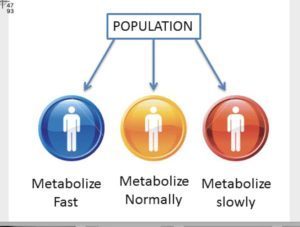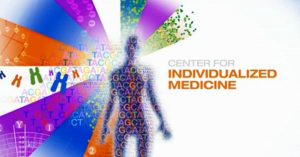Psychoactive Medication, Violence, and Variant Alleles for Cytochrome P450 Genes copy
Psychoactive Medication, Violence, and Variant Alleles for Cytochrome P450 Genes copy

Newborns and infants rapidly undergo simultaneous stages of organ growth and demonstrate large variability in drug response and metabolizing capabilities.[1,2] The enzymes, transporters and targets important for pediatric drugs all have the potential to vary along developmental timelines in terms of affinity, functional capacity and expression. Drug-metabolizing enzymes can vary according to chronological age.[3,4]
As such, determining gene expression patterns at various ontological periods becomes of key importance in formulating treatment plans for pediatric patients. Exposure to toxins or pharmaceutical agents or lack of medical treatment of a particular illness at sensitive periods of development could irreversibly disrupt the normal maturation of an individual. Observable consequences of such disruption may not appear until much later in life. READ MORE….
ASTHMA excerpt: Polymorphisms (lack of specific enzyme in individuals) have been identified within the molecular proteins and enzymes involved in the pathways by which such drugs (vaccine excipients) may bring about their effects that may influence inter-individual variation in patient response.
Cytochrome P-450 is the liver’s enzyme system and is responsible for most drug metabolism. Numerous medications, nutrients, and herbal therapies are metabolized through the cytochrome P450 (CYP450) enzyme system. This system can be inhibited or induced by drugs including excipients in vaccines. It is to be noted that cytochrome P450 is maturing and is immature in infants who are regularly vaccinated with Hepatitis B as early as one hour and those who receive the Vitamin K injection.
There are more than 50 CYP450 enzymes, but the CYP1A2, CYP2C19, CYP2D6, CYP1A2, CYP3A4, and CYP3A5 enzymes are responsible for metabolizing 45% of drug metabolism. The CYP2D6 (20–30%), the CYP2C9 (10%) and the CYP2E1 and CYP1A2 (5%) complete this enzyme system. Many ingredients in vaccines inhibit Cytochrome P450, therefore the offending agent remains in the body of the infant and toddler and act as a poison damaging the mitachondria found in every cell in the body except for the blood. If a medication is taken with an agent that inhibits its metabolism, then the toxin level can rise and result in a harmful or adverse effect.
But it is not only that “all” infants have immature Cyp 450 enzymes. For example, 10% of Caucasians are non-metabolizers (Cyp 450 2D6). For their whole life long these poor (polymorphic) metabolizers cannot metabolize 20-30% of drugs. 7% of African Americans are poor/non metabolizers of drugs dependent on CYP2D6. Due to hereditary genetic variations (not defects) they do not have the activity of Cyp 2D6. That means that children and teens given drugs such as Adderall, Haldol, Respiridal; street drugs like LSD, psilosybn, cocaine, codeine without adequate genetic pre-testing are likely to have “drug induced psychosis”; suicidal ideation, homicidal ideations by which “heinous” thoughts drive them to such violence as school shootings and mass attacks.
Medical treatments and drug protocols including vaccines should be implemented within a framework of the patient’s heritage, race, and culture in order to provide effective management modalities. Infants as well as adults should be assessed for their ability to metabolize the ingredients in vaccines.
When in comes to diet, CYP450 inducers and inhibitors are commonly ingested items such as grapefruit juice (inhibitor) and tobacco and herbs such as St. John’s Wort (inducers). In the case of grapefruit juice, there are numerous medications known to interact with grapefruit juice including statins, antiarrhythmic agents, immunosuppressive agents, and calcium channel blockers. Furthermore, the inhibition of the enzyme system seems to be dose dependent; thus, the more a patient drinks, the more the inhibition that occurs. Additionally, the effects can last for several days if grapefruit juice is consumed on a regular basis. Luckily, the effect of this is not seen with other citrus juices.
Hopefully, this brief review has opened the door to your inquisitive nature on how the liver’s enzyme system is effected by numerous medications and vaccine excipients and why some patients experience clinically significant unanticipated adverse reactions or therapeutic failures.
The above was edited and altered to include vaccines excipients from Davis’ Drug Guide
The results indicate that these non-ionic surfactants are in vitro inhibitors of CYP-mediated metabolism and might have the potential to modify the pharmacokinetics of co-administered drugs, which are substrates of CYP, and thereby enhance their bioavailability.
More on Polysorbate 80 and Polysorbate 20
Vaccination ingredients according to the product insert:
MMR II: Measles, Mumps and Rubella
http://www.merck.com/product/usa/pi_circulars/m/mmr_ii/mmr_ii_pi.pdf
The Ingredients: measles, mumps, rubella virus, neomycin, sorbitol, hydrolized gelatin, chick embryonic fluid, and human diploid cells from aborted fetal tissue.
Infanrix: Dipthetheria, Tetanus and Pertussis
http://us.gsk.com/products/assets/us_infanrix.pdf
The Ingredients: Diphtheria, Tetanus and Pertussis toxoids, 2-Phenoxyethanol, Aluminum hydroxide, and Formaldehyde.
IPOL: Polio
http://www.vaccineshoppe.com/US_PDF/IPOL_942420_11.06.pdf
The Ingredients: 3 types of polio viruses, neomycin, streptomycin, polymyxin B, formaldehyde, 2-phenoxyethenol, and a continuous line of monkey kidney cells.
Act-Hib: Haeomophilus Influenza type B
http://www.novaccine.com/pdffiles/Act_HIB_package_insert.pdf
The Ingredients: Haemophilus influenza Type B, polyribosylribitol phosphate, ammonium sulfate, formalin, and sucrose.
Menactra: Meningococcal
www.fda.gov/CbER/products/menactra.htm
The Ingredients: Neisseria meningitidis A, C, Y and W-135 strains, Mueller Hinton Agar, Watson Scherp Media, polysaccharide antigens, formaldehyde, diphtheria toxoid protein, ammonium sulfate.
Prevnar: Pneumococcal
http://www.wyeth.com/content/showlabeling.asp?id=134
The Ingredients: saccharides from capsular Streptococcus pneumoniae antigens (7 serotypes) individually conjugated to diphtheria CRM 197 protein, aluminum phosphate, ammonium sulfate, soy protein, and yeast.
Varivax: Varicella (chickenpox)
www.merck.com/product/usa/pi_circulars/v/varivax/varivaxpi.pdf
The Ingredients: varicella live virus, neomycin, phosphate, sucrose, and monosodium glutamate (MSG), processed gelatin, fetal bovine serum, guinea pig embryo cells, albumin from human blood, and human diploid cells from aborted fetal tissue.
Rotarix: Rotavirus
http://www.fda.gov/CbER/label/rotarixLB.pdf
The Ingredients: weakened human rotavirus, dextran, sorbitol, xanthan, Dulbecco’s Modified Eagle Medium (DMEM), which contains: sodium chloride, potassium chloride, magnesium sulphate, ferric (III) nitrate, sodium phosphate, sodium pyruvate, D-glucose, concentrated vitamin solution, L-cystine, L-tyrosine, amino acids solution, L-glutamine, calcium chloride, sodium hydrogenocarbonate, and phenol red.
Gardasil:HPV
http://www.merck.com/product/usa/pi_circulars/g/gardasil/gardasil_pi.pdf
The Ingredients: HPV types 6, 11, 16 and 18, saccharomyces cerevisiae, “fermentation media”, aluminum, sodium chloride, polysorbate 80, sodium borate.
FluZone (or FluShield, same product): Influenza
www.fda.gov/CBER/label/fluzoneLB.pdf
The Ingredients: Trivalent influenza virus, gentamicin sulphate, formaldehyde, thimerosal, polysorbate 80 (Tween 80) and chick embryonic fluid
Havrix: Hepatitis A
http://us.gsk.com/products/assets/us_havrix.pdf
Ingredients: Hepatitis A virus/toxoids, formalin, aluminum hydroxide, 2-phenoxyethanol, polysorbate 20, and residual MRC5 proteins -human diploid cells from aborted fetal tissue.
Energix B: Hepatitis B
http://us.gsk.com/products/assets/us_engerixb.pdf
The Ingredients: genetic sequence of the hepatitis B virus that codes for the surface antigen (HbSAg), cloned into GMO yeast, aluminum hydroxide, and thimerosal.
———————————————————————–
Comprehensive list of Xenobiotics in Vaccines: MUST SEE LIST
http://novaccine.com/vaccine-ingredients/
Aluminum= Neurotoxin
http://informedcitizensagainstvaccination.blogspot.com/2009/11/aluminum-neurotoxic-vaccine-adjuvant.html
Formaldehyde= Carcinogen (cancer causer); linked causally to an assortment of cancers, most recently Leukemia. The International Agency for Research on Cancer (IARC) classified it as a known human carcinogen in 2004.
http://informedcitizensagainstvaccination.blogspot.com/2009/11/formaldehyde-carcinogen-in-vaccinations.html
Thimerosal (mercury)= Neurotoxin; controversially linked to Autism in the media, but is well known and causally proven to cause many neurological disorders, cell death in the brain, mitochondrial damage, etcetera. Thimerosal is still being used in the Hepatitis B and Influenza vaccines as of 2009, and is also contained within several of the H1N1 vaccinations.
http://informedcitizensagainstvaccination.blogspot.com/2009/11/thimerosal-neurotoxic-in-plethora-of.html
2-Phenoxyethanol aka “Antifreeze” aka “ethylene glycol monomethyl ether”= neurotoxic, CNS toxicant.
http://informedcitizensagainstvaccination.blogspot.com/2009/11/2-phenoxyethanol-antifreeze-neurotoxin.html
Phenol= nephrotoxic; CNS toxin, heart toxin, gastrointestinal, kidney, lung and blood vessel toxin… known to induce coma’s and death; by far one of the most toxic of all vaccine ingredients.
http://informedcitizensagainstvaccination.blogspot.com/2009/11/phenol-cns-toxin-causes-comas-and-death.html
Sorbitol= cardiac toxin, causes neuropathy in and exacerbation of diabetes, CNS toxin, our own government states under no uncertain terms that this substance is NOT to be injected… then allows it to be used in childhood vaccinations.
http://informedcitizensagainstvaccination.blogspot.com/2009/11/sorbitol-cardiac-toxin-causes.html
Neomycin, Streptomycin, Polyxmyxin B, Gentamicin Sulfate= Antibiotics. Immune suppressing, lead to the development of more virulent organisms and antibacterial resistance so people cannot combat them.
http://informedcitizensagainstvaccination.blogspot.com/2009/11/antibiotics-in-vaccinations.html
Egg (chick embryonic fluid), soy, yeast, gelatin= Allergens, risk of anaphylaxis and the development of Asthma.
http://informedcitizensagainstvaccination.blogspot.com/2009/11/allergens-in-vaccinations.html
Monosodium Glutamate= Excitotoxin; hazardous to your health in so many ways: read the full length article for further details.
http://informedcitizensagainstvaccination.blogspot.com/2009/11/monosodium-glutmate-creating-dumb-obese.html
Polysorbate 80 or Tween 80= anaphylaxis risk, also permeates the BBB (blood brain barrier) which means vaccine toxins can enter the brain.
http://informedcitizensagainstvaccination.blogspot.com/2009/11/polysorbate-80-aka-tween-80-allows.html
Chick embryonic fluid, fetal bovine serum, guinea pig embryo cells, monkey kidney cells= Animal products in vaccinations that are highly susceptible to contamination. There is a particularly elevated risk with bovine serum (bovine polyomavirus) and monkey kidney cells (SV40 contamination causing cancer).
What is in the “mediums“? https://vaccineliberationarmy.com/2019/01/15/dogs-cats-increasingly-receiving-psyche-drugs-as-in-humans-its-the-vaccines/
The dangerous impurities of vaccines by Janine Roberts
http://www.foresight-preconception.org.uk/pdf/dangerous-impurities-of-vaccines.pdf

One of the biggest concerns is legal liability. Health care providers face a disconnect: Technology has outpaced their ability to interpret genetic results, such as a patient’s risk of breast cancer or heart attack from a particular mutation. Because of that, typical fallbacks including providing a rigorous standard of care—which can also act as a legal shield against malpractice claims—are becoming fuzzy. What is a doctor to do when a patient has results from a direct-to-consumer testing company like 23andMe and asks what implications they have for their health? Or when a lab notifies a doctor that a genetic variant their patient carries, thought meaningless 3 years ago, is now known to be harmful, but they can’t locate the patient? Can a testing lab be held liable for not regularly reviewing the scientific literature, to track science’s understanding of the gene variants it tests for?
This innovative 3-year project, based cooperatively at the University of Minnesota and Vanderbilt University, has convened a national Working Group of top legal and scientific experts to analyze current US federal and state law and regulation on translational genomics and to generate consensus guidance on what the law should be.


Read Study glyphosate_rats_CYP_enzyme_suppression_2006
Syngenta Patent shows that the Genetic Engineering of our nations food supply is based on Cytochrome P450 technology whereby the genetically engineered seed is manipulated to be an ultra rapidmetabolizer while the “weeds” who are normal metabolizer dies in the presence of Glysophate. Cytochrome P450 Gene Conferring herbicide resistance PATENT
Plants and humans share the same detox mechanism involving Cytochrome P450. In humans Cytocrome P450

90% of today’s modern drugs are metabolized by Cytochrome P450.
CYP1A2, CYP2C9, CYP2C19, CYP2D6, CYP3A4, and CYP3A5 enzymes metabolize 90 percent of drugs. these enzymes are predominantly expressed in the liver, but they also occur in the small intestine (reducing drug bioavailability), lungs, placenta, and kidneys.2
One out of every 15 white or black persons may have an exaggerated response to standard doses of beta blockers (e.g., metoprolol [Lopressor]), or no response to the analgesic tramadol (Ultram). This is because drug metabolism via CYP450 enzymes exhibits genetic variability (polymorphism) that influences a patient’s response to a particular drug.3
Every person inherits one genetic allele from each parent. Alleles are referred to as “wild type” or “variant,” with wild type occurring most commonly in the general population.
For example, 7 percent of white persons and 2 to 7 percent of black persons are poor metabolizers of drugs dependent on CYP2D6, which metabolizes many beta blockers, antidepressants, and opioids.7,8 One in five Asian persons is a poor metabolizer of drugs dependent on CYP2C19, which metabolizes phenytoin (Dilantin), phenobarbital, omeprazole (Prilosec), and other drugs.9
The Effect of Cytochrome P450
Metabolism on Drug Response,
Interactions, and Adverse Effects READ STUDYCyp Study

Early Childhood Vaccines contain excipients that need Cytochrome P450 to metabolize.
VLA Comment: Cytochrome P450 is not mature in infants and children under the age of three years old yet we are giving vaccines with excipients that must be detoxed out of the body by Cytochrome P450 family of liver enzymes which infants do not have. These enzymes are predominantly expressed in the liver, but they also occur in the small intestine (reducing drug bioavailability), lungs, placenta, and kidneys.2
Note in cases of Autism and vaccinating pregnant women:
Cyp 450 are found in the “Small intestines and placenta”

Excerpts:
the CYP450 enzymes are the primary catalysts for detoxification reactions that render water-insoluble molecules sufficiently water soluble to be excreted in the urine. . . . Drugs, hormones, toxins, carcinogens, mutagens, environmental pollutants, and other xenobiotics are metabolized by CYP450 enzymes.
Of the CYP450 enzyme family, there are other more specific enzymes such as CYP2C9, CYP2C19, and CYP2D6, etc. These three enzymes specifically are responsible for approximately 40% of all CYP450-mediated drug metabolism. The CYP2D6 enzyme itself is responsible for the bulk of drug metabolism at around 20% to 30% of drug metabolism in the CYP450 family.
In relation to the CYP2D6 enzyme, there are four classifications – Extensive Metabolizers (EM), Poor Metabolizers (PM), Intermediate Metabolizers (IM), and Ultrarapid Metabolizers (UM).EM (Extensive Metabolizers) are considered the “normal genotype,” “which is free of inactivating polymorphisms, deletions, or duplications.” PM (Poor Metabolizers) are individuals who have “deficient” enzyme function in terms of CYP450 metabolic processes and, subsequently, have difficulty clearing certain medications. IM (Intermediate Metabolizers) are those who have some functioning CYP450 enzymes but are subject to loss of the function of these enzymes after the “second hit” of medication, thus turning them into PM. UM (Ultrarapid Metabolizers) are those who metabolize the drug so rapidly that it clears so quickly that there is little or none of the desired effect. In medications that required metabolism to activate, however, UM individuals the metabolite may be produced too quickly, resulting in toxicity and the realization of side effects.While there are potentially adverse health effects with any one of the four classifications, the focus of this article is on those who are generally PM (Poor Metabolizers). This is because these individuals have a higher chance of experiencing adverse health effects of pharmaceuticals than those with “normal” functioning EMCYP2D6 enzymes.

| Lawyer Impulsively Jumps In Front of Train: Effexor, like All A/D’s, Can Cause Impulsivness | ||||
| Suicide | Med For Depression | 2011-11-11 | England | Physician Kills Himself Shortly After Starting an A/D |
| Personality Drained Away/Huge Weight Gain | Med For Depression | 2011-11-10 | England | After Many Years on A/D’s, Man Felt Like His Personaity Was Drained Away & He Became Obese |
| Violence | Med For Depression | 2011-11-10 | Canada | Man Strikes an Ax at a Neighbor |
| Death | Antidepressant | 2011-11-10 | England | 23 Year Old Woman Dies of Cardio-Respiratory Arrest: High Level of A/D’s in Body: No Alcohol or Drug |
| Suicide | Celexa Antidepressant | 2011-11-10 | England | Woman, 73, Kills Herself While on Celexa |
| Murder-Suicide | Prozac | 2011-11-09 | California | Man Kills Two Police Officers & Himself |
| Heart Disease | Med For Depression | 2011-11-09 | Global | ++Depression Meds Are More Likely to Cause Heart Disease |
| Murder Attempt | Med For Depression | 2011-11-08 | Malta/Mediterranean | Man Attempts to Murder Uncle With Hammer: Confused & Agitated |
| Bizarre Behavior | Lexapro & Desyrel Antidepressants | 2011-11-08 | California | +Famous Actress Kim Richards Exhibits Bizarre Behavior on TV |
| Dulled Mind/Numbed Body | Zoloft | 2011-11-07 | Georgia | Woman Physician Quits Zoloft: Tells How She Recovered From Depression |
| Suicide | Med For Depression | 2011-11-07 | Texas | Woman Drives Her Car Into Lake |
| Suicide | Antidepressants | 2011-11-05 | Ohio | Soldier, 22, Kills Himself: Black Box Warning on Suicidality for This Age Group |
The various factors that impact pharmacokinetics
and pharmacodynamics mature towards adult values at different rates, thus requiring continual modification of drug dose regimens in neonates, infants, and children.
Read Study Pediatric Population study Cyp 450.

The field of pharmacogenomics and pharmacogenetics provides a promising science base for vaccine research and development. A broad range of phenotype/genotype data combined with high-throughput genetic sequencing and bioinformatics are increasingly being integrated into this emerging field of vaccinomics. This paper discusses the hypothesis of the ‘immune response gene network’ and genetic (and bioinformatic) strategies to study associations between immune response gene polymorphisms and variations in humoral and cellular immune responses to prophylactic viral vaccines, such as measles–mumps–rubella, influenza, HIV, hepatitis B and smallpox. Immunogenetic studies reveal promising new vaccine targets by providing a better understanding of the mechanisms by which gene polymorphisms may influence innate and adaptive immune responses to vaccines, including vaccine failure and vaccine-associated adverse events. Additional benefits from vaccinomic studies include the development of personalized vaccines, the development of novel vaccines and the development of novel vaccine adjuvants.
As one clinician noted, ‘…vaccines licensed in the USA are safe and effective. However, not every vaccine is equally safe or equally effective in every person’ [2].